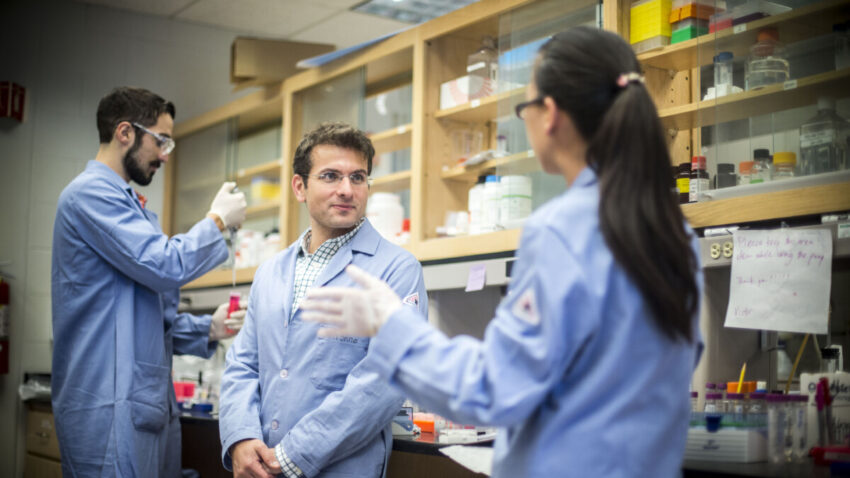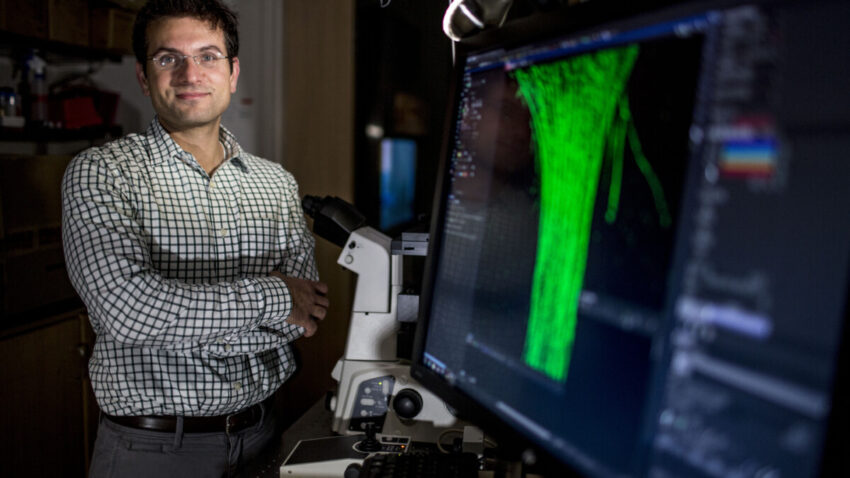Khalid Salaita, PhD has been studying the connection between chemistry and mechanical forces in his laboratory at Emory for 14 years. After completing his PhD at Northwestern University, where he studied material science and interfaces and surfaces, he completed his postdoc at UC Berkeley studying the assembly of receptor tyrosine kinase proteins in the plasma membrane. He has been leading his lab at Emory ever since, studying a wide range of questions in the chemistry field. Not only is he a professor of chemistry and a program faculty of biomedical engineering, but he also is affiliated with the Winship Cancer Institute.
What would you say first sparked your interest in mechanobiology and nanomedicine?
My interest in nanotechnology started when I was an undergraduate. There’s one observation that really blew my mind: If you take a piece of gold and shrink it down to tens of nanometers – about a thousand times smaller than the width of a human hair – it changes color. It’s no longer this yellow, shiny, gold color. Its color depends on its size. Even things like the melting temperature of gold changes when you shrink it down to that scale of nanometers. Those observations set me on this path towards studying nanoscience and materials and interfaces.
The interest in mechanobiology came later, when I was an assistant professor here and we did the very first set of experiments in my lab. In that case, we were immobilizing (sticking) small proteins on a glass slide on a chip. We were giving them to cells, and it turned out that if you tether (anchor) this protein on a glass slide or if you give it to a cell in solution, it completely changes the response. That meant that the cells are sensitive to mechanics, which led to a major part of my research program that we’re still actively working on fourteen years later.
What was a recent challenge or hurdle that you and your lab had, and how did you overcome it?
Every day of the lab is a daily challenge. Recently, we faced the challenges of competition from outside labs. I think to some, research is a solitary enterprise. You’re alone, in the lab, with your thoughts and your experiments and your test tubes. However, it’s actually a global race that becoming more international. The frequency at which we open research articles and discover that there’s another research lab hot on our heels is quite common.
A recent challenge that pertains to this notion of getting scooped is in our work with developing COVID diagnostics. There are hundreds and hundreds of new innovations in that space that are being published constantly. We opened research journals and found that there’s competing work from a team in Illinois. The first response is shock. You’re like, “Oh, what do we do now?” Then, you pause and look carefully at the science. If you’re doing basic science (this is luckily what we were doing), the fact that there is competing work is not too much of a concern. If you keep it fundamental, then you can draw clear lines of what basic questions you’re asking. So, we had to refocus our questions and make sure that we stay clear of that competing work.
How often does this competition lead to further collaboration?
In some cases, it does lead to collaboration. There’s a number of cases where, either meeting at a conference or knowing somebody who knows somebody who knows our work, led to communication with another lab that’s doing something very similar. I can cite examples with a team at University of Minnesota and another example with a team at Boston University where the competition then subsequently led to collaboration, sharing data, sharing results, and publishing articles that cited each other.
How do you balance the goals of research and commercialization?
Sometimes, research and commercialization are aligned. The best example is our work in mechanobiology and mechanotransduction. In that case, we were simply curious: How do cells sense forces, how do they convert them into biochemical signals, and how do we control forces so that we can better understand this conversion process?

Chemist Khalid Salaita has developed the fastest, most robust DNA motor yet known.
That’s the basic question, but because mechanobiology is critical to many processes like the development of cancer and the immune response, that naturally blends into potential applications in cancer diagnostics and immunotherapy.
But, in other cases it doesn’t, and they’re completely at odds. Something could have a high commercialization potential, but low basic research potential. You could do a project that doesn’t have a wide application; it’s not something that branches like a tree and allows you to expand and learn more about the universe. Rather, it’s a very specific application. Can you make this process more efficient? Can you detect COVID on a more sensitive level? In that case, we must remind ourselves as scientists that we’re still doing basic research and that commercialization is best suited to be done in industry. Our role really is to open those new doors and let industry carry on with the more applied side of things.
What advice would you give to your younger self?
I would go back in a time machine and say, “Relax and enjoy the ride. No matter what challenges and competition you face, it’s going to be all okay.” I think it’s hard to keep reminding myself of that because of this constant anxiety and the rush to find the next discovery and the next big breakthrough and the next piece of funding. But really, I just need to enjoy the moment because it’s fun at the end of the day.
– Masin Kearney
Learn more about Khalid Salaita, PhD, in this extended video interview!